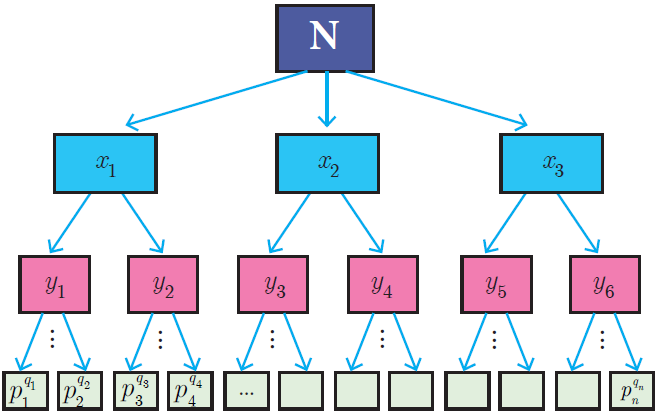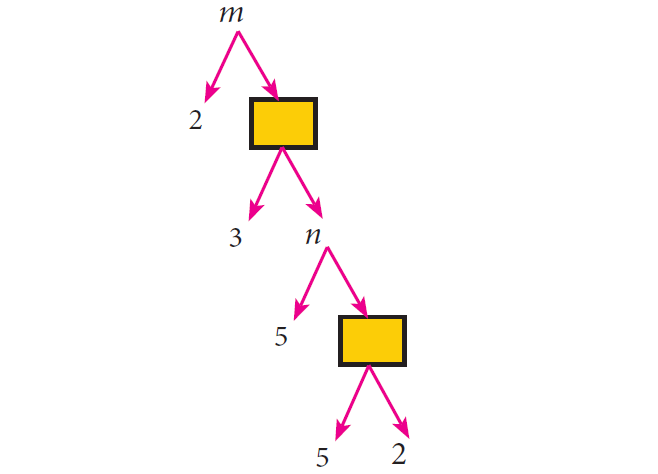FUNDAMENTAL THEOREM OF ARITHMETIC
Subscribe to our ▶️ YouTube channel 🔴 for the latest videos, updates, and tips.
Every natural number except 1 can be factorized as a product of primes and this factorization is unique except for the order in which the prime factors are written.
The fundamental theorem asserts that every composite number can be decomposed as a product of prime numbers and that the decomposition is unique. In the sense that there is one and only way to express the decomposition as product of primes.

In general, we conclude that given a composite number N, we decompose it uniquely in the form

where p1, p2, p3, ...., pn are primes and q1, q2, q3, ...., qn are natural numbers.
First, we try to factorize N into its factors. If all the factors are themselves primes then we can stop. Otherwise, we try to further split the factors which are not prime. Continue the process till we get only prime numbers.
Writing the primes in ascending order makes the factorization unique in nature.
Illustration :
For example, if we try to factorize 32760 we get
32760 = 2 x 2 x 2 x 3 x 3 x 5 x 7 x 13
= 23 x 32 x 51 x 71 x 131
Thus, in whatever way we try to factorize 32760, we should finally get three 2’s, two 3’s, one 5, one 7 and one 13.
The fact that “Every composite number can be written uniquely as the product of power of primes” is called Fundamental Theorem of Arithmetic.
Significance of the Fundamental Theorem of Arithmetic
The fundamental theorem about natural numbers except 1, that we have stated above has several applications, both in Mathematics and in other fields. The theorem is vastly important in Mathematics, since it highlights the fact that prime numbers are the ‘Building Blocks’ for all the positive integers. Thus, prime numbers can be compared to atoms making up a molecule
1. If a prime number p divides ab then either p divides a or p divides b. That is p divides at least one of them.
2. If a composite number n divides ab, then n neither divide a nor b. For example, 6 divides 4 x 3 but 6 neither divide 4 nor 3.
Example 1 :
In the given factor tree, find the numbers m and n.

Solution :
Value of the first box from bottom = 5 x 2 = 10.
Value of n = 5 x 10 = 50.
Value of the second box from bottom = 3 x 0 = 150.
Value of m = 2 x 150 = 300.
Thus, the required numbers are m = 300, n = 50.
Example 2 :
Can the number 6n, n being a natural number end with the digit 5? Give reason for your answer.
Solution :
Since 6n = (2 x 3)n = 2n x 3n, 2 is a factor of 6n . So, 6n is always even.
But any number whose last digit is 5 is always odd.
Hence, 6n cannot end with the digit 5.
Example 3 :
Is 7 x 5 x 3 x 2 + 3 a composite number? Justify your answer.
Solution :
Yes, the given number is a composite number, because
7 x 5 x 3 x 2 + 3 = 3(7 x 5 x 2 + 1) = 3 x 71
Since the given number can be factorized in terms of two primes, it is a composite number.
Example 4 :
a and b are two positive integers such that ab x ba = 800. Find a and b.
Solution :
The number 800 can be factorized as
800 = 2 x 2 x 2 x 2 x 2 x 5 x 5 = 25 x 52
Hence, ab x ba = 25 x 52.
This implies that a = 2 and b = 5 (or) a = 5 and b = 2.
Example 4 :
Explain why (5×7×11+11) and (6 × 5 × 4 × 3 × 2 × 1 + 5) are composite numbers.
Solution :
= 5 × 7 × 11 + 11
Factoring 11, we get
= 11 (5 × 7 + 1)
=11 × 36
=11 × 2 × 2 × 3 × 3
= 22 × 32 × 11
So, it is composite
(6 × 5 × 4 × 3 × 2 × 1 + 5)
Factoring 5 out, we get
= 5 x (6 × 4 × 3 × 2 × 1 + 1)
= 5 x (2 x 3 × 2 x 2 × 3 × 2 × 1 + 1)
= 5 x (24 x 32 + 1)
The product of these two numbers will not have only two factors. It will have more factors. Then it is composite.
Example 5 :
If the HCF of two numbers is 1, then the two numbers are called.
a) composite b) Relative prime or co-prime
c) Perfect d) irrational numbers
Solution :
The consecutive numbers which will have highest common factor which is 1. Then the required number is relative prime or coprime.
Subscribe to our ▶️ YouTube channel 🔴 for the latest videos, updates, and tips.
Kindly mail your feedback to v4formath@gmail.com
We always appreciate your feedback.
About Us | Contact Us | Privacy Policy
©All rights reserved. onlinemath4all.com

Recent Articles
-
US Common Core K-12 Curricum Algebra Solving Simple Equations
Jan 06, 26 04:54 AM
US Common Core K-12 Curricum Algebra Solving Simple Equations -
10 Hard SAT Math Questions (Part - 4)
Jan 05, 26 06:56 PM
10 Hard SAT Math Questions (Part - 4) -
10 Hard SAT Math Questions (Part - 3)
Jan 05, 26 06:34 PM
10 Hard SAT Math Questions (Part - 3)

